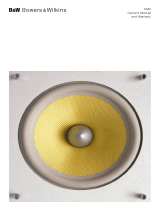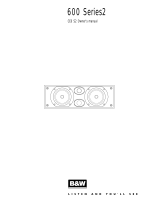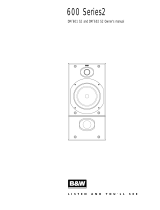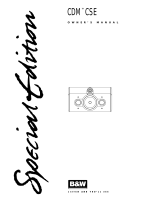English
Limited Warranty
Dear customer,
Welcome to B&W.
This product has been designed and
manufactured to the highest quality
standards. However, if something does go
wrong with this product, B&W
Loudspeakers and its national distributors
warrant free of charge labour (exclusion
may apply) and replacement parts in any
country served by an official B&W
distributor.
This limited warranty is valid for a period of
five years from the date of purchase or two
years for electronics including amplified
loudspeakers.
Terms and Conditions
1 The warranty is limited to the repair of
the equipment. Neither transportation,
nor any other costs, nor any risk for
removal, transportation and installation
of products is covered by this warranty.
2 This warranty is only valid for the
original owner. It is not transferable.
3 This warranty will not be applicable in
cases other than defects in materials
and/or workmanship at the time of
purchase and will not be applicable:
a. for damages caused by incorrect
installation, connection or packing,
b. for damages caused by any use other
than correct use described in the user
manual, negligence, modifications, or
use of parts that are not made or
authorised by B&W,
c. for damages caused by faulty or
unsuitable ancillary equipment,
d. for damages caused by accidents,
lightning, water, fire heat, war, public
disturbances or any other cause
beyond the reasonable control of B&W
and its appointed distributors,
e. for products whose serial number has
been altered, deleted, removed or
made illegible,
f. if repairs or modifications have been
executed by an unauthorised person.
4 This guarantee complements any
national/regional law obligations of
dealers or national distributors and
does not affect your statutory rights as
a customer.
How to claim repairs under
warranty
Should service be required, please follow
the following procedure:
1 If the equipment is being used in the
country of purchase, you should
contact the B&W authorised dealer
from whom the equipment was
purchased.
2 If the equipment is being used outside
the country of purchase, you should
contact B&W national distributor in the
country of residence who will advise
where the equipment can be serviced.
You can call B&W in the UK or visit our
web site to get the contact details of
your local distributor.
To validate your warranty, you will need to
produce this warranty booklet completed
and stamped by your dealer on the date of
purchase. Alternatively, you will need the
original sales invoice or other proof of
ownership and date of purchase.
Owner’s manual
Introduction
Thank you for choosing Bowers & Wilkins.
We are confident that you will enjoy many
years of listening pleasure from your
speakers, but please read this manual fully
before installing them. It will help you
optimise their performance.
The speaker is primarily intended for home
theatre installations, but is equally at home
with 2-channel audio. Separate sections in
the manual are devoted to the two
applications.
B&W maintains a network of dedicated
distributors in over 60 countries who will be
able to help you should you have any
problems your dealer cannot resolve.
Unpacking (figure 1)
• After opening the top carton flaps,
remove the grille and foam plug from the
polystyrene tray.
• Fold the carton flaps right back and
invert the carton and contents.
• Lift the carton clear of the contents and
remove the inner packaging from the
speakers.
• Remove the protection cover from the
tweeter and fit the grille if required,
applying pressure over the position of the
pegs.
We suggest you retain the packing for
futureuse.
Positioning
All Applications
The speaker may be used in either vertical
or horizontal orientation. However, vertical
orientation offers better horizontal
dispersion and is to be preferred in most
cases as this leads to a more stable image
over a wide listening area.
Horizontal orientation can be used with little
detriment to the imaging if the speaker is
used in the front centre position of a home
theatre installation where the listeners are
within 15˚ of the centre line – equivalent to
0.8m at a listening distance of 3m.
The speaker has a reflex port at the rear.
Leave at least 10cm clear space between
the back of the speaker and the wall
behind, to allow the port to operate
properly.
NOTE: The badge on the grille can be
rotated through 90 degrees to suit the
orientation of the speaker. Pull the badge
slightly away from the grille against spring
pressure, and turn.
Fix the 4 self-adhesive pads to the base of
the speaker. They give a degree of vibration
isolation, especially useful if placing the
speaker directly on top of a fairly flimsy
television. The flat area on top of the
television may be smaller than the base of
the speaker, so position the feet
accordingly.
Home Theatre (figure 2)
As a front centre speaker:
If using a projection television with an
acoustically transparent screen, place the
speaker behind the centre of the screen.
Otherwise position it directly above or
below the screen, whichever is closest to
ear level. Align the front of the speaker
approximately level with the screen.
As a front left and right speaker:
As an initial guide:
• Make the height of the tweeter
approximately the same as the centre
speaker.
• Space the speaker between 0.5m and
1m from the side of the screen.
As a surround speaker:
There are two ways of presenting surround
information. You can either attempt to get
good imaging in all directions or go for a
more diffuse, ambient effect. The choice is
made more difficult by the fact that some
movies are produced assuming a diffuse
surround presentation and others attempt
to portray more precise imaging.
In both cases position the speakers to the
sides and behind the listeners.
For more precise imaging, mount the
speakers at or just above ear height and
point them at the listening area. (figure 3)
Do not expect the imaging to the sides and
rear to be as precise as at the front.
Phantom images between the speakers are
fairly easy to create with sustained tones,
but fricative or percussive sounds can tend
to localise more at the speakers. It is also
difficult to get an ideal balance between
front and surround speakers for more than
one row of listeners.
For a more diffuse effect, mount the
speakers higher and point them along
either the rear or side wall. (figure 4)
2-Channel Audio (figure 5)
Mount the speakers so that the tweeters
are approximately at ear level.
As an initial guide:
• Position the speakers and the centre of
the listening area approximately at the
corners of an equilateral triangle.
• Keep the speakers at least 1.5m apart to
maintain left-right separation.
• Keep the speaker baffles at least 0.5m
clear of walls.
Stray magnetic fields
The speaker drive units are magnetically
shielded such that the stray magnetic field
outside the boundaries of the cabinet,
except the front, is too low to cause
distortion of the television picture in the
vast majority of cases.
1























